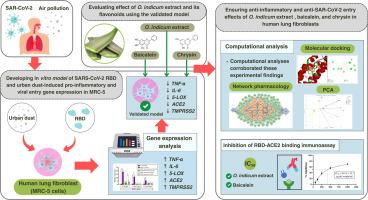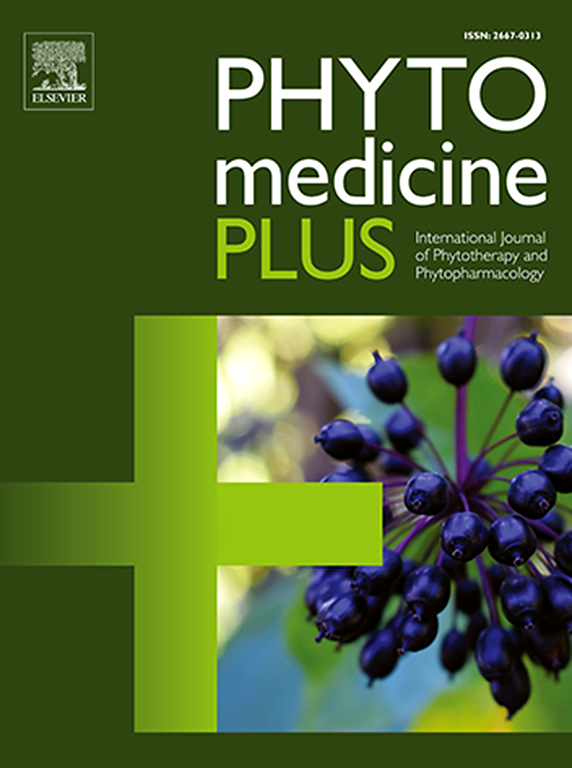牛耳草及其黄酮类化合物对SARS-CoV-2和城市粉尘诱导的人肺成纤维细胞炎症的影响
Q3 Pharmacology, Toxicology and Pharmaceutics
引用次数: 0
摘要
sars - cov -2感染和慢性城市粉尘暴露可通过刺激促炎细胞因子导致肺部炎症和纤维化。籼稻(Oroxylum indicum)库尔茨及其类黄酮,黄芩素和菊花素,显示出治疗肺损伤的潜力。目的通过体外人肺成纤维细胞模型,研究黄芩素、黄芩素和菊花素对RBD和城市粉尘诱导的炎症的影响以及COVID-19的关键进入机制。方法将人肺成纤维细胞暴露于RBD或城市粉尘中。定量检测TNF-α、IL-6、5-LOX、ACE2、TMPRSS2的相对基因表达。酶联免疫吸附试验(ELISA)检测RBD-ACE2结合抑制作用。计算分析包括PCA、分子对接和网络药理学等来探索潜在的机制。结果RBD和城市尘埃均显著增加基因表达,RBD上调IL-6,城市尘埃上调TNF-α。地塞米松抑制了它们,验证了模型。梧桐提取物、黄芩素和菊花素显著降低TNF-α、IL-6和5-LOX的表达。梧桐提取物持续下调ACE2和TMPRSS2的表达,降低RBD和城市尘埃诱导的炎症。黄芩素和O. indicum提取物抑制RBD-ACE2结合(IC₅₀分别= 4.60±0.7µM和435.4±52.7µg/ml)。实验结果得到了计算分析的支持。结论本研究验证了体外模型的有效性,证明了牡荆提取物、黄芩素和菊花素具有减轻肺部炎症和干扰SARS-CoV-2进入机制的潜力。进一步的研究应包括蛋白质水平分析和体内研究,以确认治疗效果。本文章由计算机程序翻译,如有差异,请以英文原文为准。

Oroxylum indicum and its flavonoids impact on SARS-CoV-2 and urban dust-induced inflammation in human lung fibroblast cells
Background
SARS-CoV-2 infection and chronic urban dust exposure can lead to lung inflammation and fibrosis by stimulating pro-inflammatory cytokines. Oroxylum indicum (L.) Kurz and its flavonoids, baicalein and chrysin, demonstrate potential to treat pulmonary damage.
Purpose
This study evaluated the effects of O. indicum grilled fruit extract, baicalein, and chrysin against receptor-binding domain (RBD)- and urban dust-induced inflammation and key COVID-19 entry mechanisms using an in vitro human lung fibroblast model.
Methods
Human lung fibroblasts were exposed to RBD or urban dust. Relative gene expressions of TNF-α, IL-6, 5-LOX, ACE2, and TMPRSS2 were quantified. Enzyme-linked immunosorbent assay (ELISA) determined RBD–ACE2 binding inhibition. Computational analyses to explore potential mechanisms included PCA, molecular docking, and network pharmacology.
Results
Both RBD and urban dust dramatically increased genes, with RBD upregulating IL-6 and urban dust upregulating TNF-α. Dexamethasone suppressed them, validating the model. O. indicum extract, baicalein, and chrysin significantly reduced TNF-α, IL-6, and 5-LOX expression. O. indicum extract consistently downregulated ACE2 and TMPRSS2 expressions and decreased RBD and urban dust-induced inflammation. Baicalein and O. indicum extract inhibited RBD–ACE2 binding (IC₅₀ = 4.60 ± 0.7 µM and 435.4 ± 52.7 µg/ml, respectively). Experimental results were supported by computational analysis.
Conclusion
This research validates the in vitro model and demonstrates that O. indicum extract, baicalein, and chrysin have the potential to mitigate pulmonary inflammation and interfere with SARS-CoV-2 entry mechanisms. Further investigation should include protein-level analysis and in vivo studies confirming therapeutic efficacy.
求助全文
通过发布文献求助,成功后即可免费获取论文全文。
去求助
来源期刊

Phytomedicine Plus
Medicine-Complementary and Alternative Medicine
CiteScore
3.70
自引率
0.00%
发文量
178
审稿时长
81 days
期刊介绍:
 求助内容:
求助内容: 应助结果提醒方式:
应助结果提醒方式:


